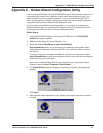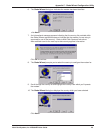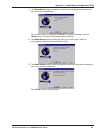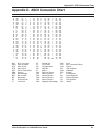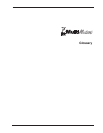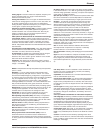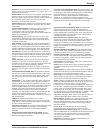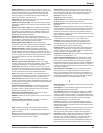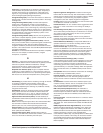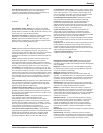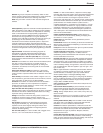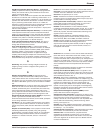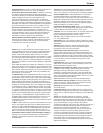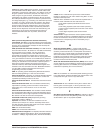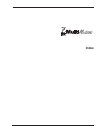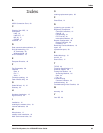
Glossary
Multi-Tech Systems, Inc. MT5634ZPX User Guide 55
Frequency: A characteristic of an electrical or electronic signal
which describes the periodic recurrence of cycles. Frequency is
inversely proportional to the wavelength or pulse width of the
signal (i.e., long wavelength signals have low frequencies and
short wavelength signals yield high frequencies).
Foreign Exchange (FX): A CO trunk with access to a distant CO,
allowing ease of access and flat-rate calls anywhere in the foreign
exchange area.
Foreign Exchange Office (FXO): Provides local telephone
service from a CO outside of (“foreign” to) the subscriber’s
exchange area. In simple form, a user can pick up the phone in
one city and receive a tone in the foreign city. Connecting a POTS
telephone to a computer telephony system via a T1 link requires a
channel bank configured for the FX connection. To generate a call
from the POTS set to the computer telephony system, a FXO
connection must be configured.
Foreign Exchange Station (FXS): See FX, FXO. To generate a
call from the computer telephony system to the POTS set, an FXS
connection must be configured.
Forward Explicit Congestion Notification (FECN): A bit that
tells you that a certain frame on a particular logical connection has
encountered heavy traffic. The bit provides notification that
congestion-avoidance procedures should be initiatedin the same
direction of the received frame. See also BECN (Backward Explicit
Congestion Notification).
Function: A Universal Serial Bus device that provides a capability
to the host. For example, an ISDN connection, a digital
microphone, or speakers.
G
Gateway: 1. A functional unit that interconnects two computer
networks with different network architectures. A gateway connects
networks or systems of different architectures. A bridge
interconnects networks or systems with the same or similar
architectures. 2. A network that connects hosts.
Graphical User Interface (GUI): A type of computer interface
consisting of a visual metaphor of a real-world scene, often of a
desktop. Within that scene are icons, representing actual objects,
that the user can access and manipulate with a pointing device.
H
Handshaking: A process that two modems go through at the time
of call setup to establish synchronization over the data
communications link. It is a synchronization and negotiation
process accomplished by the exchange of predefined, mutually
recognized control codes.
Hexadecimal: A base 16 numbering system used to represent
binary values. Hex uses the numbers 0-9 and the letters A-F:
usually notated by an “h” (e.g., “4CF h”, read “four charley fox,
hex”). The result is that one hex digit represents a 4-bit value.
High-level Data Link Control (HDLC): An ISO standard, bit-
oriented data communications protocol that provides nearly error-
free data transfers.
Host: The host computer system where the Universal Serial Bus
host controller is installed. This includes the host hardware
platform (CPU, bus, etc.) and the operating system in use.
Host Controller: The host’s Universal Serial Bus interface. A
hardware device that provides the interface to the Host Controller
Driver (HCD) and the USB bus.
Host Controller Driver (HCD): Software that provides an
interface to the USB Driver and the Host Controller. (The interface
to the Host Controller is defined by the OHCI spec.
I
Implicit congestion management: A method of informing the
terminal that the network is busy. This method relies on the end-
system protocol to detect and fix the congestion problem. (TCP/IP
is an example of a protocol using only implicit congestion
management.) See also “explicit congestion management”.
In-band: Refers to the type of signalling over the conversion path
on an ISDN call. Contrast “out-of-band”.
Insufficient Ones: A T1 error condition that is logged when fewer
than one 1 in 16 0s or less than 12.5 % average 1s density is
received.
Inter Exchange Carrier (IEC): The long distance company (LE)
who’s central office provides the point of reference for T1 access.
Any common carrier authorized by the FCC to carry customer
transmissions between LATAs.
Internet: Refers to the computer network of many millions of
university, government and private users around the world. Each
user has a unique Internet Address.
Internet Address (IP Address): A unique 32-bit address for a
specific TCP/IP host on a network. Normally printed in dotted
decimal format (e.g., 129.128.44.227).
Internet Protocol (IP): A protocol used to route data from its
source to its destination in an Internet enviroment. The Internet
Protocol was designed to connect local area networks. Although
there are many protocols that do this, IP refers to the global
system of interconnecting computers. It is a highly distributed
protocol (each machine only worries about sending data to the
next step in the route).
Internetwork Packet Exchange (IPX): A NetWare
communications protocol used to route messages from one node
to another. IPX packets include network addresses and can be
routed from one network to another. An IPX packet can
occasionally get lost when crossing networks, thus IPX does not
guarantee delivery of a complete message. Either the application
has to provide that control, or NetWare’s SPX protocol must be
used.
Interoperable: Devices from different vendors that can exchange
information using a standard’s base protocol.
Interrupt Request: A hardware signal that allows a device to
request attention from a host. The host typically invokes an
interrupt service routine to handle the condition which caused the
request.
I/O Addresses: Locations within the I/O address space of your
computer used by a device, such as an expansion card, a serial
port, or an internal modem. The address is used for
communication between software and a device.
IRQ Level (Interrupt Request Level): The notification a
processor receives when another portion of the computer’s
hardware requires its attention. IRQs are numbered so that the
device issuing the IRQ can be identified, and so IRQs can be
prioritized.
Isochronous data: Information delivered in a continuous stream
at a steady rate.
ISA (Industry Standards Architecture) (pronounced “ice a”):
The classic 8 or 16-bit architecture introduced with IBM’s PC-AT
computer.
ISDN (Integrated Services Digital Network): An International
telecommunications standard for transmitting voice, video and
data over a digital communications line. ISDN is a world-wide
telecommunications service that uses digital transmission and
switching technology to support voice and digital data
communications. Frame relay was partially based on ISDN’s data
link layer protocol (LAPD). Frame relay can be used to transmit
across ISDN services offering circuit-switched connection at 64
Kbps and higher speeds. Contrast Public Switched Telephone
Network (PSTN).



